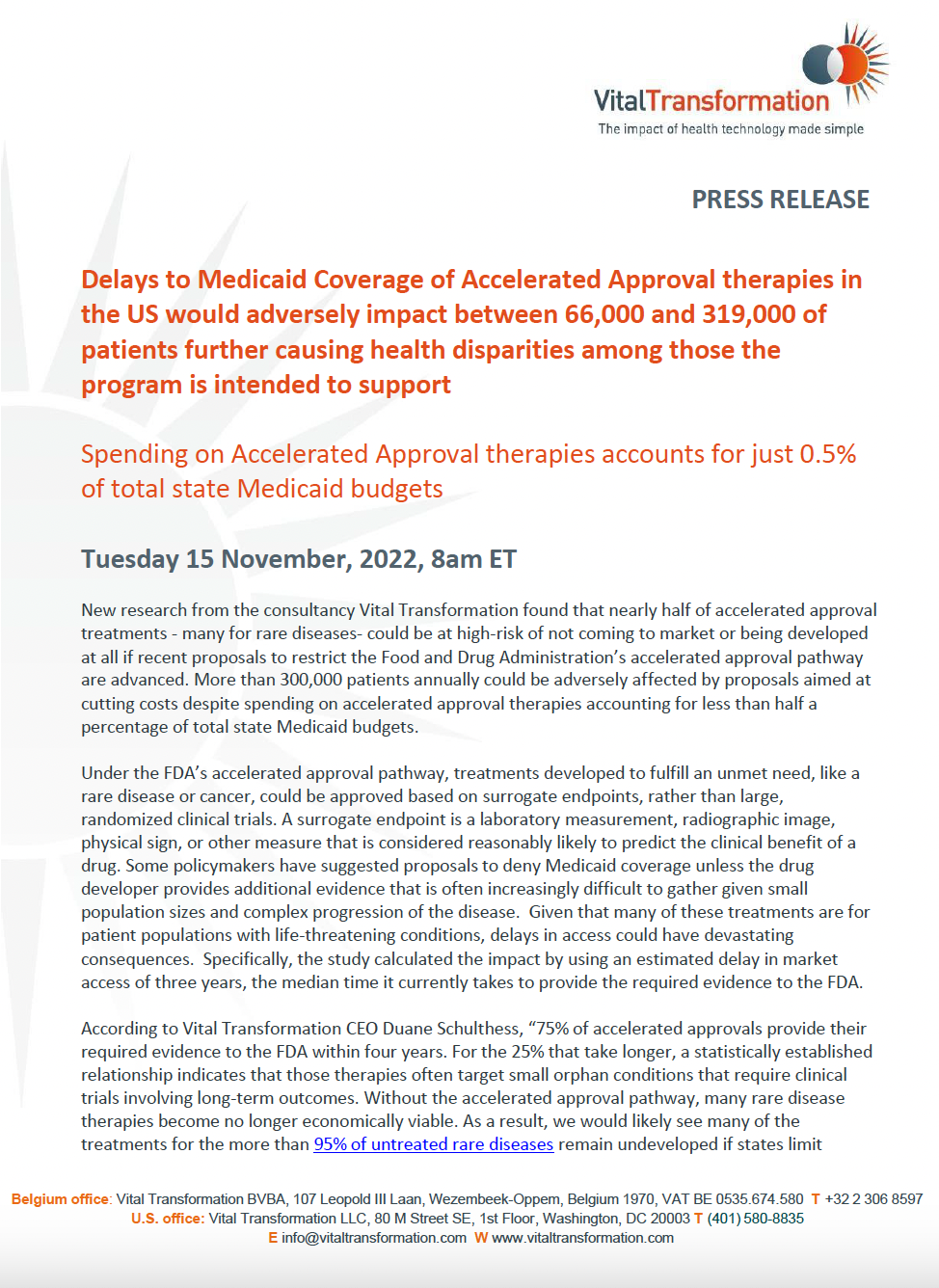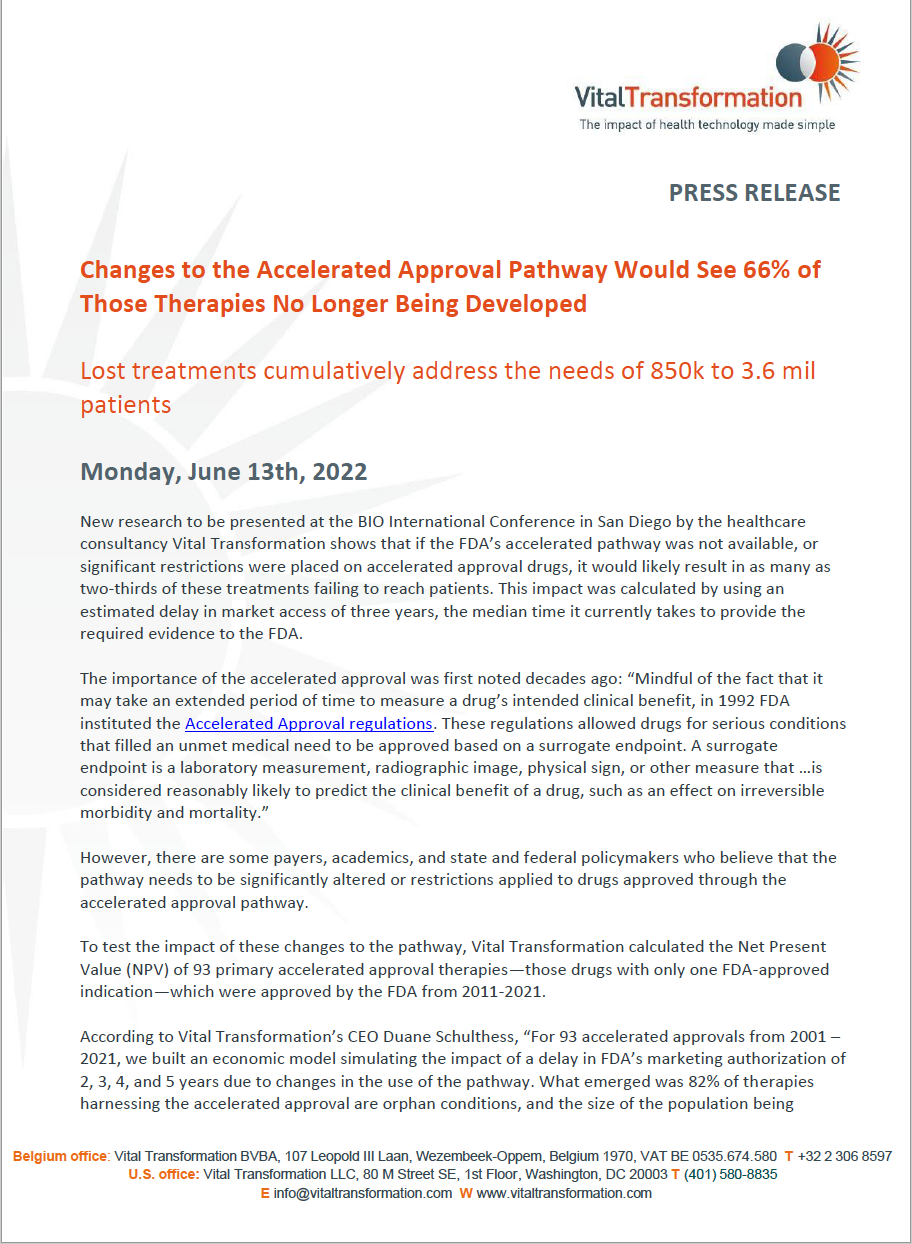Calculating the Value and Impact of Accelerated Approvals: Final Findings
The Executive Summary
- The Accelerated Approval (AA) pathway was implemented to help fight AIDs/HIV and has largely been considered a success in addressing areas of high unmet medical needs. However, there is growing sentiment from some payers, academics, and state and federal policymakers that the pathway needs to be significantly altered or restrictions applied to drugs approved through the accelerated approval pathway
- To test the impact of these changes to the pathway, Vital Transformation calculated the Net Present Value (NPV) of 93 primary accelerated approval therapies from 2001-2021 (drugs with at least one FDA-approved indication):
-
- The cost estimates were derived from two peer review publications by Jayasundara and DiMasi, scaled to the actual size of the FDA approved confirmatory trial in our cohort,
- An economic model was built testing the impacts of 2, 3, 4, and 5-year delays in the granting of a full FDA marketing approval to determine the NPV of any accelerated approval therapy.
- For most of the orphan conditions currently lacking treatment in the US, each condition impacts a maximum of 330 people – an incidence rate less than 1/1,000,000. Substantial changes to the accelerated approval pathway will likely render the potential development of these therapies to treat many rare diseases economically untenable
- The Accelerated Approval therapies’ relative impact on state Medicaid budgets is minimal with an average of one-half of one percent, 0.5%, across all 50 US states and DC
- A three-year delay in Medicaid access in 100% of states would result in roughly 19% – 43% of our therapies having a negative NPV which would therefore render development unlikely.
- Revenue reductions have the consequence of increasing risks for developers/investors – even though Medicaid therapies are highly discounted, large revenue reductions do increase the likelihood of fewer therapies being introduced to the market under the Accelerated Approval pathway.
Key Findings
- We estimate that 33% to 66% of accelerated approvals at the median delay of three years will no longer have a net positive NPV, and a company may no longer invest in the therapy, or its development could be halted.
- 82% of accelerated approvals are for orphan indications; smaller confirmatory trials take longer to meet their FDA requirements; larger and faster confirmatory trials predict a positive NPV with statistical significance (p < 0.0004).
- Secondary indications appear to be a logical strategy to ensure an overall net positive NPV and help to retain drugs in the market, but genetically targeted therapies don’t have the opportunity for secondary indications.
- Gleevec, Opdivo, and Keytruda have over 50% of all secondary indications awarded, as they are highly effective late-stage treatments for cancer.
- There is a 63% probability that a therapeutically significant therapy (blockbuster) was created by a small company (<$ 500 mil annual revenue); >80% of small IP producing companies are based in the US.
- 85% of untreated orphan indications have incidence rates less than 1/1,000,000; changes to the accelerated approval pathway will render the development of those therapies economically untenable.
- Negatively impacting the accelerated approval pathway will lead to therapies leaving or not coming to market; these at-risk therapies cumulatively address the needs of 850k to 3.6 mil patients, depending upon our cost assumptions and estimated delay time.
- If changes to the current FDA accelerated pathway are made and a three-year delay occurs, we estimate that 20%-40% of all accelerated approvals to no longer have a positive NPV and would therefore be at high-risk of not coming to market – especially if state Medicaid MACPAC rebates between 30%-40% were to become applied.
- Accelerated Approvals represent a small fraction of US States’ overall Medicaid spending. Should a three-year delay come to fruition, between 66,000 and 319,000 state Medicaid program beneficiaries would lose access to new treatments with neurology and oncology being the most impacted.
Supported by:






